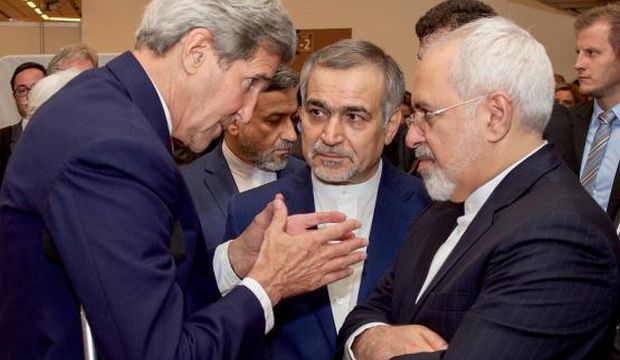
US Secretary of State John Kerry (L) speaks with Hossein Fereydoun (C), the brother of Iranian President Hassan Rouhani, and Iranian Foreign Minister Mohammad Javad Zarif (R), before Kerry and Zarif address an international press corps gathered at the Austria Center in Vienna, Austria, on July 14, 2015, following negotiations on Iran’s nuclear program. (Reuters)
London, Asharq Al-Awsat—After almost two years of intense diplomacy regarding Iran’s nuclear program, Iran and the P5+1 group led by the United Sates have produced a 159-page document, labeled a “deal” designed to curb Iran’s program in exchange for an easing and eventual lifting of sanctions.
The truth, however, is that there has been no deal—yet.
What we have is the promise of a deal.
Speaking in Tehran on Monday President Hassan Rouhani said what was published is a “press statement” not an agreement. He hopes that an agreement will be reached in two months’ time with the presentation of a draft resolution to the United Nations Security Council.
The 159-page document studiously avoids such diplomatic terms as “memorandum of understanding,” “agreement,” and “accord,” let alone “treaty,” and is presented as the Joint Comprehensive Plan of Action (JCPOA), or “Barjam” in Persian. Under it Iran is supposed to take a number of measures voluntarily in exchange for the lifting of sanctions by the UN and a range of other advantages promised by the P5+1.
No one has signed anything if only because the US-led P5+1 group is an ad hoc informal entity with no legal existence or authority.
On the Iranian side, Ali Akbar Velayati, foreign policy adviser to “Supreme Guide” Ayatollah Ali Khamenei, insists that promises made by the Iranian team in Vienna “have no value” unless endorsed by the big boss in Tehran. On the P5+1 side the text would become operational once it is approved at the UN Security Council.
In the case of the US there is an additional hurdle: securing the Senate’s approval for the JCPOA before Washington is authorized to vote for the projected UN resolution.
There are significant differences between the English and Persian texts of the JCPOA. Iran tries to hide the fact that it has ignored some of the “red lines” fixed by the “Supreme Guide,” notably regarding the instant lifting of all sanctions and the rejection of arbitration by the International Atomic Energy Agency (IAEA).
The US, for its part, wishes to camouflage its retreat on “red lines” fixed by President Barack Obama, especially with regard to inspection of Iranian military sites and the length of time Iran would remain under international probation.
Even then, no one is sure that the plan will work. This is why Iran and the P5+1 have agreed to continue the process of negotiations at lower levels, and with foreign ministers meeting every two years or earlier to smooth things over.
The way the text is written, including a jungle of details big enough for a dozen devils to hide in, shows the depth of mistrust between the two sides. However, if it works it will give both sides a number of advantages, at least at tactical level. President Obama will be able to cool down the crisis, leaving it for his successor. President Rouhani will be able to use unfrozen Iranian assets, initially valued at over 50 billion US dollars, to revive an anemic economy while financing foreign policy schemes in Iraq, Syria, Lebanon, Bahrain, and Yemen among other places. An upturn in the Iranian economy could help the Rafsanjani faction, of which Rouhani is a member, win next year’s elections for the Islamic Majlis and the Assembly of Experts, reducing the influence of more radical factions around the “Supreme Guide.”
Some analysts, of course, also hope that the Iranian leadership might taste the benefits of less provocative politics and modulate its behavior accordingly.
As Rouhani said yesterday: Today we see the birth of hope.
